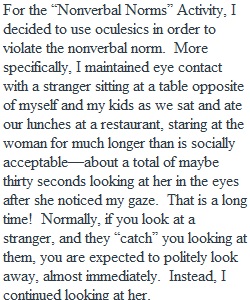


Q Nonverbal communication follows certain “norms” or “rules” for situations and contexts. • Some of these are written while others are un-written. • These nonverbal communication rules/norms may come from society, your family, your job, etc. • For example, turning around and facing the doors after we enter an elevator, talking quietly in a library, not sitting/standing too close to people we don't know, . Task: Identify a situation where you will consciously violate or break a nonverbal norm or rule. Please choose wisely – do not get arrested, do not get fired, do not get excommunicated from your family. After the task you may want to tell those involved what you were doing and why. Then answer the following discussion questions: 1. What is the nonverbal norm/rule you violated? What exactly did you do? Make sure it is clear how this violates what is considered the norm or rule for that situation or context. (use terminology from the text regarding the "10 Channels of Nonverbal Communication" when deciding what to do and when referencing types of nonverbals in your post. Ex: kinesics, oculesics, proxemics, paralanguage, facial expressions, posture, etc. ) 2. How did you feel as you were breaking the norm? Was it awkward? Were you embarrassed? Nervous about how others would react?, etc. 3. Describe the nonverbal reactions of those around you when you violated the “norm/rule.” What did they do? What were their nonverbals? Again, use terminology from the text related to the "10 Channels of Nonverbal Communication" when discussing nonverbals i.e. kinesics, oculesics, proxemics, paralanguage, facial expressions, posture, etc. 4. Respond to at least one classmate's post.
View Related Questions